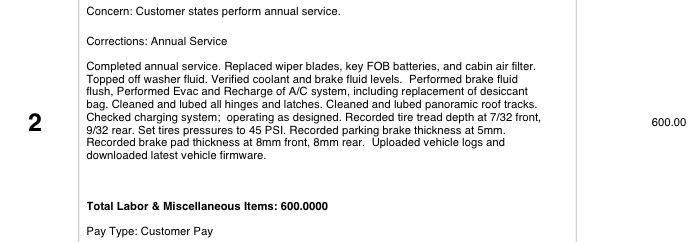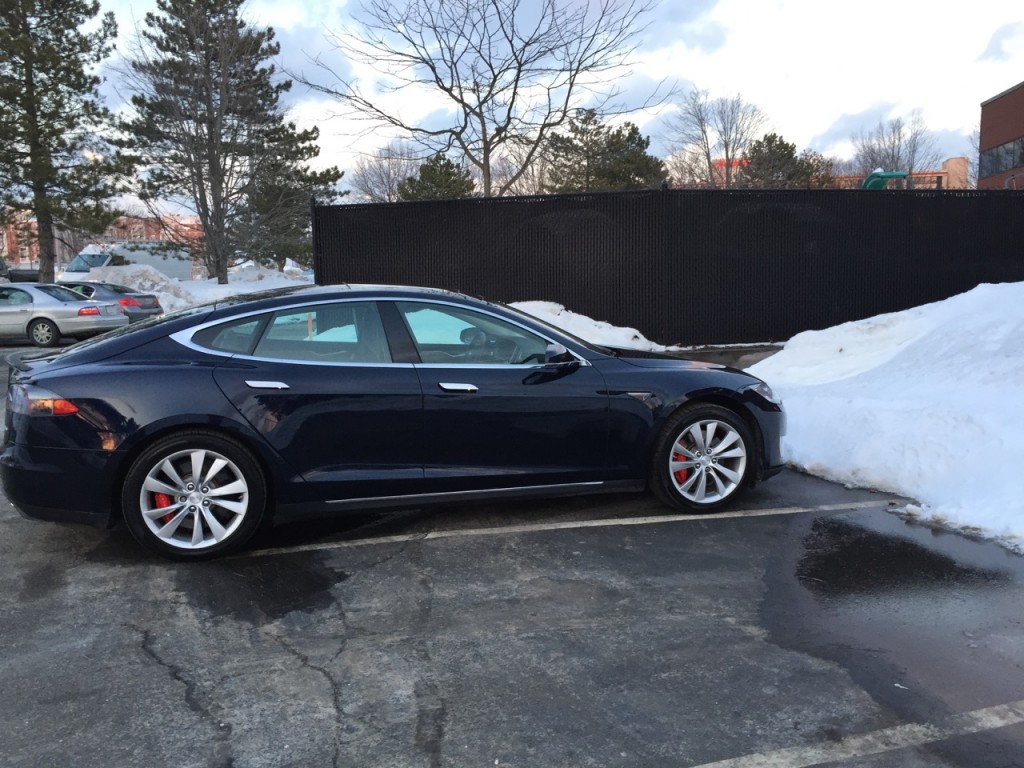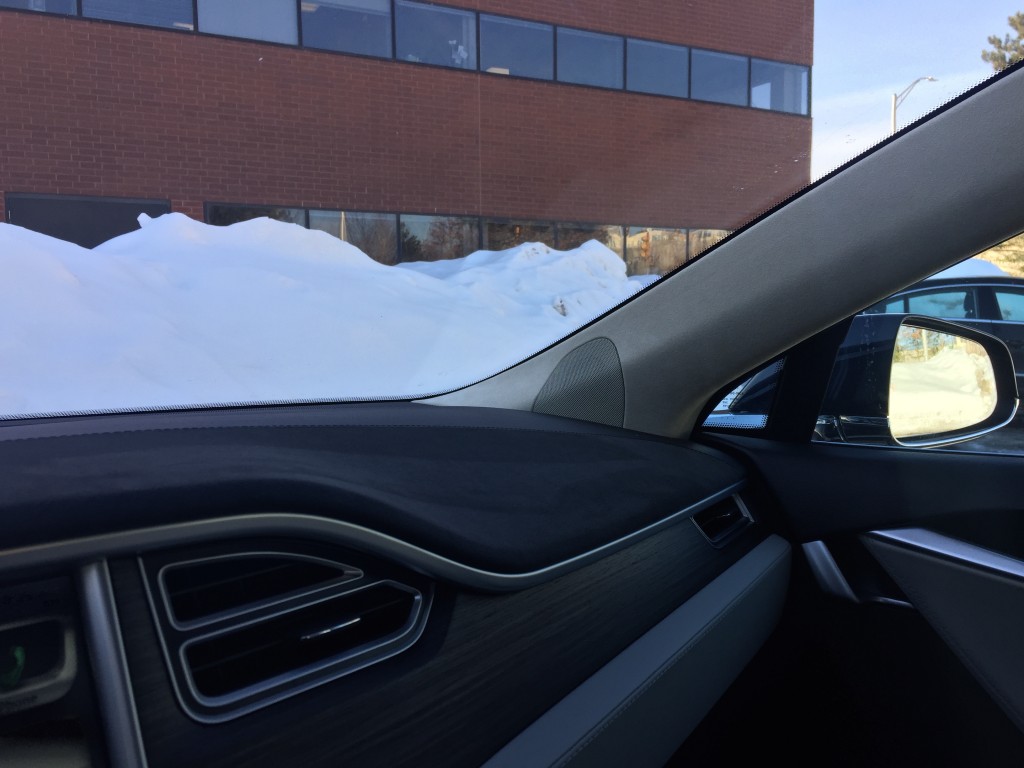News
What Goes Into a Tesla Model S Annual Service?
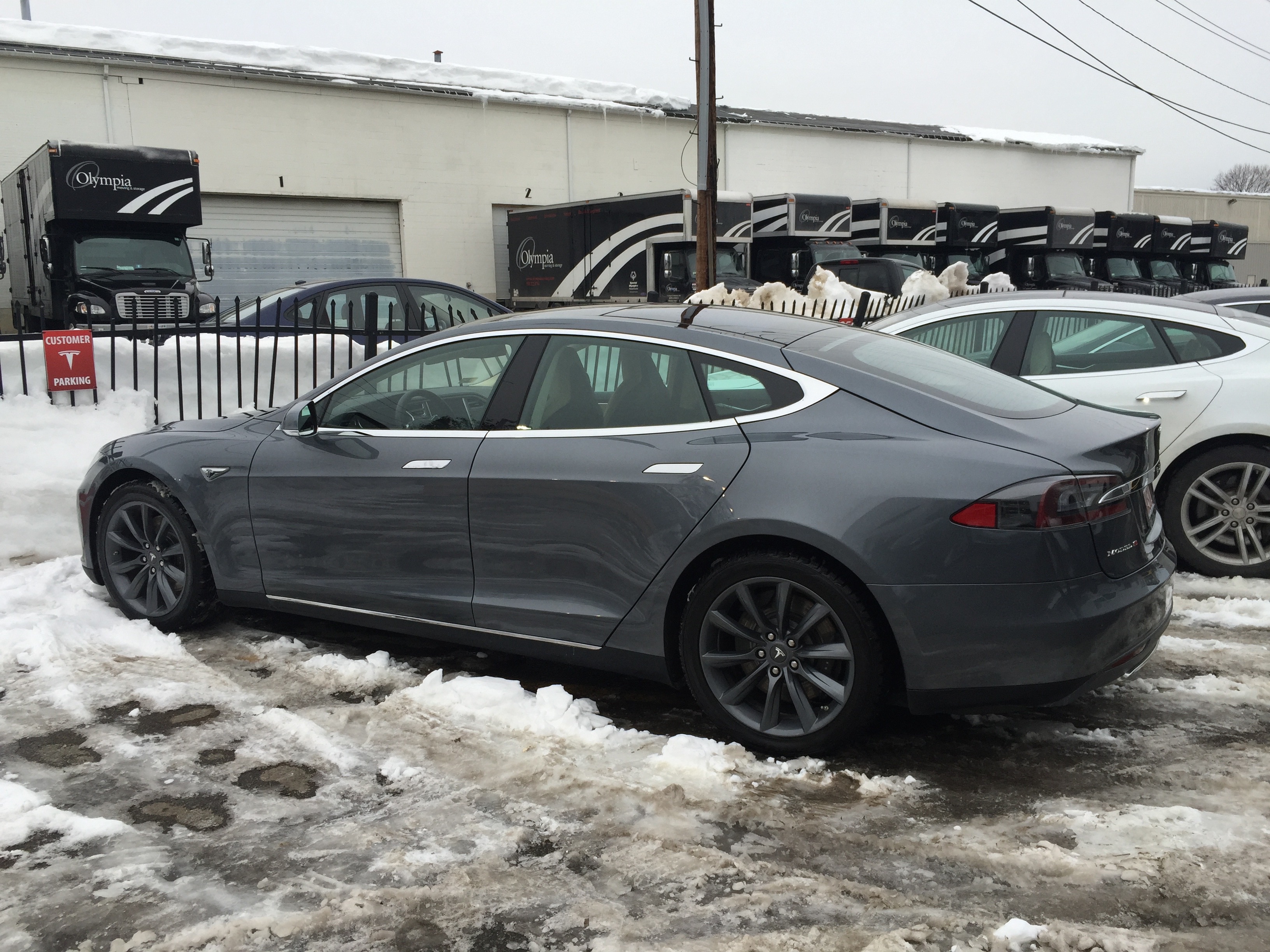
 I’m still shy of the 12 month mark on owning my Model S, but I just had my first annual service and wanted to share my thoughts and experience on Tesla’s annual service.
I’m still shy of the 12 month mark on owning my Model S, but I just had my first annual service and wanted to share my thoughts and experience on Tesla’s annual service.
Frequency of Service
Tesla recommends that you have your Model S serviced every 12,500 miles or every 12 months, whichever comes first. This has always been problematic for me since I drive 30,000 miles a year. So by their rules I’d be getting an “annual” service every 5 months.
When I explained this to my Tesla rep during delivery of my Model S, they had recommended that I perform the service at 24,000 miles which seemed very arbitrary to me, but that’s what I did.
At 24,000 miles (less than 10 months into ownership) I called for an Annual Service appointment. The service person I spoke to was shocked I hadn’t had my car serviced yet with all those miles and I explained that I had been following their recommendation. My appointment was booked 3 weeks out. It wasn’t urgent so timing wasn’t a big deal, but it did mean that I would be going in for my first service at 25,500 miles.
When should I take my Model S in?
I took to the TMC forum and asked other owners what their Tesla annual service experience was like. Universally, owners are treating the annual service as just that, an annual service regardless of miles and type of service needed. However similar to my experience, some owners are receiving mixed guidance from Tesla on when the annual service should really take place.
This gets even more confusing when it comes to those with the pre-paid service plan. I did an analysis of Tesla’s pre-paid service plan when purchasing the car and realized that it just wasn’t for me
One Model S owner who goes by the handle of AmpedRealtor received the following email from Jerome Guillen, former VP, Worldwide sales and service (he just changed roles):
Dear Mr. [AmpedRealtor]:
Any customer who has paid for a 4-year service plan is entitled to 4 “annual service” visits. The customer can elect to bring the car whenever they desire: we recommend every year or every 12,500 miles (whichever comes first), but the customer are free to do whatever they essentially desire. They can bring the car every 18 months or every 6 months. In the end, they will receive the 4 “annual service” they have paid for. I hope this clarifies the situation.
Many thanks for your continued support. Best regards,
Jerome Guillen | VP, WW sales and service
While thats a nice email and statement, it isn’t what the contract says when you sign up for the pre-paid plan. So while Elon, Jerome, and others have stated other things its hard to commit to a contract that clearly states something different and then expect otherwise.
Ultimately, Tesla needs to get their act together on what an Annual Service really entails and make sure the paperwork matches the intent.
What Goes Into the Tesla Annual Service?
The Annual Service price (if not pre-paid) is $600. Its an all-day affair and usually involves you dropping off your car and getting a loaner.
In many areas, Tesla offers a valet service (for free) where they’ll pick up your car and drop off a loaner, but they’ve started clamping down on that service. Nowadays it seems that they only want to do the valet service if you’re within 10 miles of the Tesla Service Center. I wasn’t offered valet service (I work 14 miles from the service center) and dropped my car off myself which wasn’t a big deal — I always love seeing all the Tesla’s on their lot.
The actual annual service was described as follows on my invoice:
They basically go over the car and check everything out. Along the way they’ll also perform any other needed updates where needed.
There was a service bulletin:
Bulletin: Model S | SB-14-17-002 | Corrosion on 12V Positive Jump Post
And I had some corrosion so they replaced the parts that were of concern.
They also did more than a normal “Annual” service since I was at twice the mileage for the annual and evidently they have different types of service at different mileages. This one they called:
24 Month/25000 Mile/40000 km Service (with Coil Suspension)
For that part of the service they removed, cleaned and lubricated front and rear brake pads and performed an alignment with some minor adjustments.
So while the service is annual, they do different things based on the mileage on the car again somewhat contradicting ideas of coming in whenever you want or only once a year regardless of mileage.
Extra Items
I generally have a list of less urgent items that I want addressed each time I go into the service center. I had two open issues this time as follows:
- One of my Tesla UMCs was not working.
- My right front tire was somehow rubbing when the wheel was at full turn and at low speeds (usually reversing into a spot).
The UMC (my original one that came with the car) was faulty and they replaced it for free after testing it themselves. I’m a little concerned it didn’t even last a year before failing but at least it was covered by the warranty. Fortunately when it failed I had a spare and had started using that after several bad charges with the original UMC.
To address the rubbing noises coming from the right front tire, Tesla mostly blamed the noise on my aftermarket Tsportsline wheels and Nokian tires but was able to address it with a wheel alignment. I don’t really buy that the aftermarket parts were the issue given there’s a forum discussion going on with owners with the exact same issue on the same front right wheel. But whatever they tweaked, it is much better now. I think their design tolerances in the wheel well are too tight.
Oddly they had an item on the service sheet as a customer complaint from me that I didn’t bring up when making the appointment:
Concern: Customer states cruise control is not working normally.
This was actually derived from an email to ownership a few months before the service about the problems around limited regeneration in the cold. It wasn’t a complaint about the car as it was working as designed, it was a suggestion that they may want to review how things worked in that area as I thought there was a safety issue.
Tesla collects all concerns / complaints that you email them with and will include it into your service checklist.
Getting a Loaner
Any service event (planned or unplanned) is an opportunity to experience a Model S with a different set of configurations. While I was hoping for a P85D, I ended up with a beautiful blue P85+.
While the extra performance was nice, I wasn’t blown away by it since I had a lot more trouble with keeping the wheels from spinning. With my S85 I really have to work at losing traction and the traction control does a great job. With the P85+ (it had winter tires on too, Sottozero) the tires spun a lot and I didn’t like the experience — the power was too much for either the tires or the traction control or both.
The other thing the car had that was new for me was the Alcantara headliner. I really liked the look of it and would have to think hard on that option next time. I’d want to hear about maintenance/cleaning experiences first though.
Summary
My first paid Tesla service appointment in over 25,000 miles cost a total of $600 and was overall a good experience. I felt that it was good value for the amount of work Tesla did on the car. Tesla did everything I expected (and more) and returned my car cleaner inside and out than it has been in many months of driving through a harsh New England winter.
Granted it got dirty before I even reached home but it was still great to see how beautiful the car looked when clean. I’m ready for spring.

News
Tesla dominates in the UK with Model Y and Model 3 leading the way
Credit: Tesla China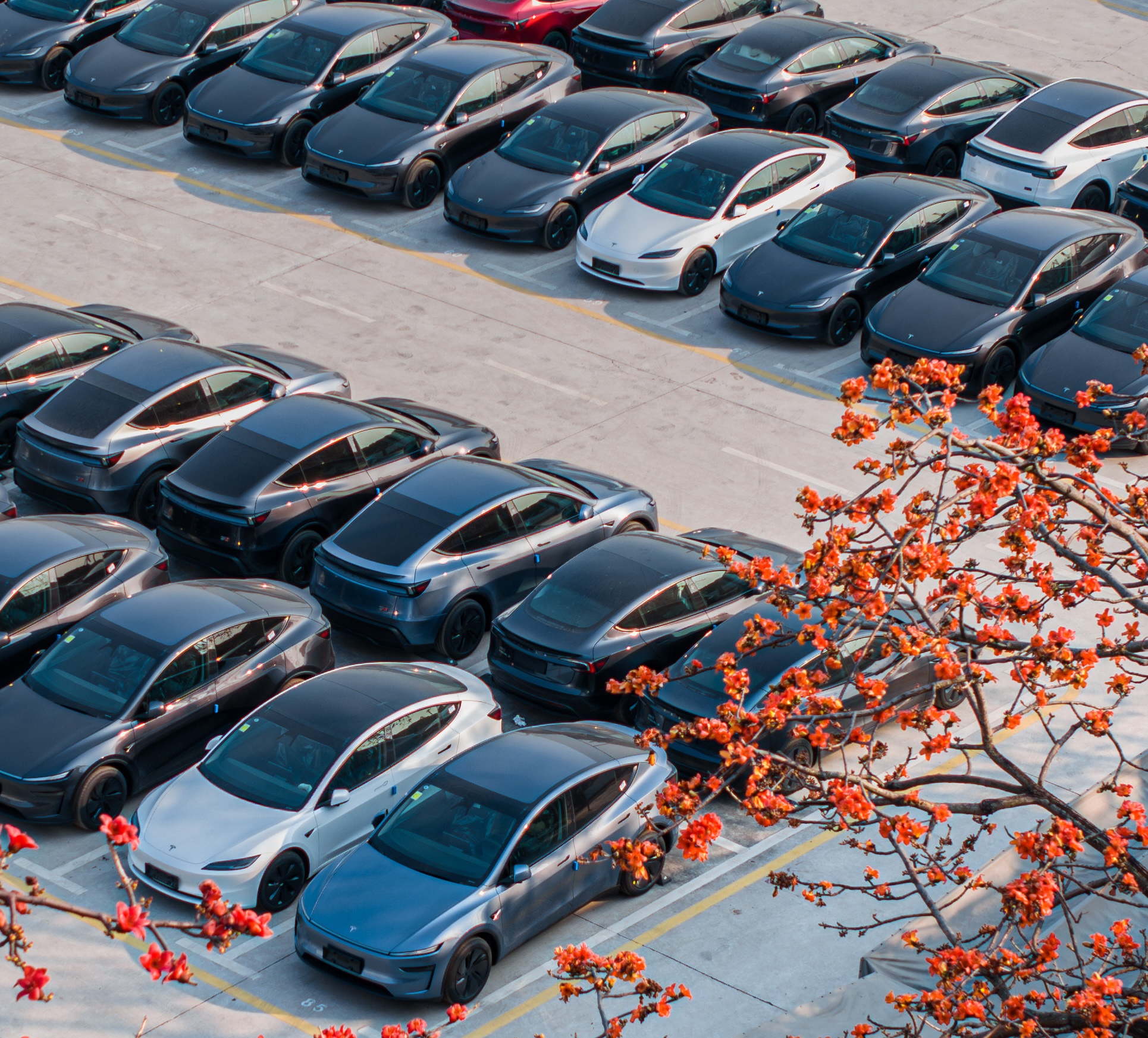
Tesla is dominating in the United Kingdom so far through 2025, and with about two weeks left in the year, the Model Y and Model 3 are leading the way.
The Model Y and Model 3 are the two best-selling electric vehicles in the United Kingdom, which is comprised of England, Scotland, Wales, and Northern Ireland, and it’s not particularly close.
According to data gathered by EU-EVs, the Model Y is sitting at 18,890 units for the year, while the Model 3 is slightly behind with 16,361 sales for the year so far.
The next best-selling EV is the Audi Q4 e-tron at 10,287 units, lagging significantly behind but ahead of other models like the BMW i4 and the Audi Q6 e-tron.
GOOD NEWS 🇬🇧 Tesla is absolutely crushing the UK electric vehicle market in 2025 💥
The numbers are in, and the dominance is clear. With an impressive amount of 42,270 vehicles delivered year-to-date, the brand now commands a solid 9.6% market share of the total auto market 🆒… pic.twitter.com/dkiGX9kzd0
— Ming (@tslaming) December 18, 2025
The Model Y has tasted significant success in the global market, but it has dominated in large markets like Europe and the United States.
For years, it’s been a car that has fit the bill of exactly what consumers need: a perfect combination of luxury, space, and sustainability.
Both vehicles are going to see decreases in sales compared to 2024; the Model Y was the best-selling car last year, but it sold 32,610 units in the UK. Meanwhile, the Model 3 had reached 17,272 units, which will keep it right on par with last year.
Tesla sold 50,090 units in the market last year, and it’s about 8,000 units shy of last year’s pace. It also had a stronger market share last year with 13.2 percent of the sales in the market. With two weeks left in 2025, Tesla has a 9.6 percent market share, leading Volkswagen with 8 percent.
The company likely felt some impact from CEO Elon Musk’s involvement with the Trump administration and, more specifically, his role with DOGE. However, it is worth mentioning that some months saw stronger consumer demand than others. For example, sales were up over 20 percent in February. A 14 percent increase followed this in June.
News
Tesla Insurance officially expands to new U.S. state
Tesla’s in-house Insurance program first launched back in late 2019, offering a new way to insure the vehicles that was potentially less expensive and could alleviate a lot of the issues people had with claims, as the company could assess and repair the damage itself.
Credit: Tesla Insurance
Tesla Insurance has officially expanded to a new U.S. state, its thirteenth since its launch in 2019.
Tesla has confirmed that its in-house Insurance program has officially made its way to Florida, just two months after the company filed to update its Private Passenger Auto program in the state. It had tried to offer its insurance program to drivers in the state back in 2022, but its launch did not happen.
Instead, Tesla refiled the paperwork back in mid-October, which essentially was the move toward initiating the offering this month.
BREAKING: Tesla Insurance has just officially launched in Florida.
This is the first new state to receive @Tesla Insurance in more than 3 years. In total, Tesla insurance is now available in 13 U.S. states (map in thread below of all the states).
Tesla Insurance in Florida uses… pic.twitter.com/bDwh1IV6gD
— Sawyer Merritt (@SawyerMerritt) December 17, 2025
Tesla’s in-house Insurance program first launched back in late 2019, offering a new way to insure the vehicles that was potentially less expensive and could alleviate a lot of the issues people had with claims, as the company could assess and repair the damage itself.
It has expanded to new states since 2019, but Florida presents a particularly interesting challenge for Tesla, as the company’s entry into the state is particularly noteworthy given its unique insurance landscape, characterized by high premiums due to frequent natural disasters, dense traffic, and a no-fault system.
Annual average premiums for Florida drivers hover around $4,000 per year, well above the national average. Tesla’s insurance program could disrupt this, especially for EV enthusiasts. The state’s growing EV adoption, fueled by incentives and infrastructure development, aligns perfectly with Tesla’s ecosystem.
Moreover, there are more ways to have cars repaired, and features like comprehensive coverage for battery damage and roadside assistance tailored to EVs address those common painpoints that owners have.
However, there are some challenges that still remain. Florida’s susceptibility to hurricanes raises questions about how Tesla will handle claims during disasters.
Looking ahead, Tesla’s expansion of its insurance program signals the company’s ambition to continue vertically integrating its services, including coverage of its vehicles. Reducing dependency on third-party insurers only makes things simpler for the company’s automotive division, as well as for its customers.
News
Tesla Full Self-Driving gets sparkling review from South Korean politician
“Having already ridden in an unmanned robotaxi, the novelty wasn’t as strong for me, but it drives just as well as most people do. It already feels like a completed technology, which gives me a lot to think about.”
Credit: Soyoung Lee | X
Tesla Full Self-Driving got its first sparkling review from South Korean politician Lee So-young, a member of the country’s National Assembly, earlier this week.
Lee is a member of the Strategy and Finance Committee in South Korea and is a proponent of sustainable technologies and their applications in both residential and commercial settings. For the first time, Lee was able to utilize Tesla’s Full Self-Driving technology as it launched in the country in late November.
Her thoughts on the suite were complimentary to the suite, stating that “it drives just as well as most people do,” and that “it already feels like a completed technology.”
드디어 오늘, 서울에서 테슬라 FSD 체험 했습니다.
JiDal Papa님의 모델S 협찬에 힘입어^^ 파파님 정말 감사합니다.
국회 -> 망원시장 -> 홍익대 -> 국회 복귀 코스였고요.
이미 무인 로보택시를 타봐서 그런지 신기함은
덜했지만, 웬만한 사람만큼 운전을 잘하네요.이미 완성된 기술이라고… pic.twitter.com/8pAidHBpRG
— 이소영 국회의원 (Soyoung Lee) (@im_soyounglee) December 17, 2025
Her translated post says:
“Finally, today I got to experience Tesla FSD in Seoul. Thanks to the Model S sponsored by JiDal Papa^^, I’m truly grateful to Papa. The route was from the National Assembly -> Mangwon Market -> Hongik University -> back to the National Assembly. Having already ridden in an unmanned robotaxi, the novelty wasn’t as strong for me, but it drives just as well as most people do. It already feels like a completed technology, which gives me a lot to think about. Once it actually spreads into widespread use, I feel like our daily lives are going to change a lot. Even I, with my license gathering dust in a drawer, don’t see much reason to learn to drive a manual anymore.”
Tesla Full Self-Driving officially landed in South Korea in late November, with the initial launch being one of Tesla’s most recent, v14.1.4.
It marked the seventh country in which Tesla was able to enable the driver assistance suite, following the United States, Puerto Rico, Canada, China, Mexico, Australia, and New Zealand.
It is important to see politicians and figures in power try new technologies, especially ones that are widely popular in other regions of the world and could potentially revolutionize how people travel globally.
